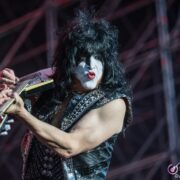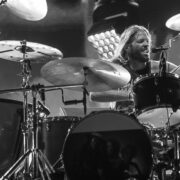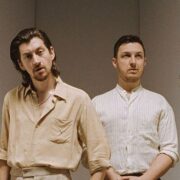Autore prolifico come pochi, Thomas Eriksen torna con il nuovo album della creatura solista Mork a qualche a mese di distanza dalla release omonima del progetto parallelo Udåd. In “Syv”, settimo lavoro di una discografia dalla buonissima qualità media, il norvegese continua il medesimo discorso esplorativo di “Dypet”, congiungendo liriche introspettive e ispirate al folklore della propria terra d’origine a un black metal ricco di suggestioni molteplici, ormai quasi del tutto autonomo dalla patria potestà della second wave dei Fiordi. Di questo e altro si parla nell’intervista con il sempre disponibile musicista di Halden.
— SCROLL DOWN TO READ THE ENGLISH VERSION —
Ciao Thomas e bentornato su SpazioRock. Come stai? Ti siamo molto affezionati, viste le tue numerose interviste sulla nostra webzine…
Ehi, sto bene! Anzi, abbastanza bene. A questo punto, siamo diventati vecchi colleghi!
Sono trascorsi soltanto pochi mesi dall’uscita dell’omonimo album di debutto del tuo progetto parallelo a nome Udåd, in cui hai riversato tutto l’amore per un black metal arcaico e volutamente regressivo. Che reazione hai ricevuto dai tuoi fan e dalla critica per un album molto diverso dagli ultimi lavori dei Mork?
Onestamente, non credo che molte persone abbiano ancora ascoltato “Udåd”. È rimasto sospeso sotto la superficie fino a oggi, quasi nella totale oscurità. Le poche recensioni che ho letto sono state positive, però. E anche la risposta degli ascoltatori è stata buona. È un album che entra in risonanza con le persone, suppongo. Speriamo e vediamo se verrà “scoperto” in futuro, perché ne sono davvero soddisfatto.
Concentriamoci, ora, sul nuovo album “Syv“, che, come suggerisce il titolo medesimo, è il settimo lavoro in studio di Mork. Perché hai voluto dare al disco un nome così breve e minimale, che ricorda l’omonimo film di David Fincher? Volevi suscitare lo stesso effetto sorpresa?
Mi sono graditi i titoli brevi e d’impatto. Mi piace anche l’estetica pura delle parole e come esse suonano e appaiono. “Syv”, per me, era un titolo perfetto, perché non ho esitato affatto e l’ho trovato abbastanza rapidamente. Adoro quel film di cui parli, di sicuro, così come la questione dei “peccati capitali”. Tuttavia, sette è un numero con diverse interpretazioni e può avere significati diversi. Lascia che sia un mistero. Dichiariamo l’ovvio: è il settimo capitolo a firma Mork.
In confronto all’artwork di “Dypet”, realizzato da David Thiérrée, la copertina di “Syv” sembra più cupa, ma anche meno nebbiosa. Chi è l’autore della cover? E quali significati intende comunicarci?
Dapprincipio, avrei dovuto usare solo una silhouette delle cime degli alberi di una foresta come sfondo per i loghi. Ma il grafico mi ha suggerito di far dipingere lo sfondo a un artista. È così che ho iniziato a lavorare con Kjell Åge Meland, che ha fatto un lavoro meraviglioso sulla foresta, che ora esalta molto la copertina. Ho anche detto a David Thiérrée che volevo un logo appropriato per “Syv”, e lui ha colto nel segno al primo tentativo. Non c’è un significato eccessivamente complesso dietro l’artwork, se non che la foresta è il luogo dove nasce Mork. Ero anche pronto a provare qualcosa di nuovo per quanto riguarda la grafica, che ora contiene anche un po’ di colore.
Ancora una volta, hai curato personalmente la registrazione e il mixaggio del platter, mentre del mastering si è occupato un grande professionista come Maor Appelbaum. Che tipo di suono hai pensato di conferire all’album rispetto al passato? E sei soddisfatto del risultato finale?
Voglio che gli album suonino bene senza abbandonare la crudezza su cui sono costruiti. Questo nuovo disco, dal punto di vista sonoro, dovrebbe essere il migliore sino a oggi e ne sono molto soddisfatto. La Enormous Door Mastering e Maor Appelbaum hanno stretto una buona collaborazione.
In “Dypet“, i testi esploravano le profondità dell’animo umano, intrecciando introspezione e storie del folklore norvegese. Cosa hai esplorato nei pezzi di “Syv”?
Più o meno gli stessi temi. Folklore e storia si possono trovare in tracce come “Holmgang” ed “Heksebål”. Il fattore umano sarà sempre presente nei testi di Mork, perché è la cosa più affascinante e reale in cui io possa scavare. Immagino che questo disco sia fortemente influenzato dalla mortalità e dall’invecchiamento, dato che ho compiuto quarant’anni quest’estate. Tracce come “Utbrent”, “Tidens Tann” e “Omme” sono tutte di questo tipo.
Lo stile di Mork, soprattutto dopo i primi due dischi, si è via via evoluto, abbracciando un black metal aperto alle contaminazioni, pur mantenendo un proprio marchio di fabbrica riconoscibile. “Syv”, con i suoi arrangiamenti raffinati e stratificati, è il full-length nel quale cui hai definitivamente messo a nudo la tua anima dark e progressive rock?
È il risultato del fatto che non seguo le regole e lascio che ciò che deve accadere accada. Ci sono elementi di ogni tipo di musica combinati in maniera libera. È davvero gratificante poter creare canzoni senza pensare “deve suonare così o così” o “non posso fare quello o usare quello“. Se funziona, funziona.
Ascoltando i vari frammenti del lotto, e mi riferisco in particolare a “I Tåkens Virvel” e alla stessa “Til Syvende Og Sist”, torna con maggiore forza una delle peculiarità di Mork, ovvero l’uso del basso melodico come strumento guida dei brani. Consideri questo approccio, che potremmo definire post punk, uno dei tuoi aspetti più originali?
La mia principale ispirazione per il basso è Geezer Butler, suppongo. E i bassisti degli anni ’70 in generale, immagino. Ma il mio approccio alla costruzione delle linee di basso deriva più dal mio modo di suonare la chitarra. Nel corso degli anni, imparando a suonarla, ho ovviamente compreso come costruire gli accordi, il che è un ottimo mezzo se vuoi cambiare l’umore usando il basso, capire quali note possono essere capovolte sulla nota fondamentale e così via. Per me, essere punk significa, fondamentalmente, attenersi ai riff. Cliff Williams degli AC/DC, d’altro canto, mi ha insegnato a rimanere sulla nota fondamentale anche quando cambia la chitarra, il che è davvero efficace in certi passaggi.
Un’altra traccia da evidenziare è la già citata ballad acustica “Omme”. Come nasce questa canzone così suggestiva? Ed è davvero la pista giusta per chiudere il long playing?
Lo chiedi in un modo che chiaramente dimostra che non sei d’accordo con la mia scelta (ride, ndr). Va bene, però. Sì, è una conclusione appropriata nella mia mente. Immagino che il brano sia più incisivo quando conosci la lingua, non c’è dubbio. È più o meno una lettera di suicidio. Qualcuno alla fine della corda senza più un cazzo da dare. Il vero dolore e la bruttezza non devono essere espressi attraverso chitarre distorte e batteria a volume sparato tutto il tempo. Questi testi, insieme a un pezzo musicale che ricorda quasi una ninna nanna tradizionale, hanno funzionato davvero per me.
Il monicker Mork festeggia quest’anno il suo ventesimo anniversario. Se dovessi parlare con il Thomas Eriksen del 2004, cosa gli diresti? Gli consiglieresti di intraprendere strade diverse dal punto di vista artistico e umano?
Non gli direi niente. Non si scherza con il passato. La vita è fatta per essere vissuta, nel bene e nel male. Tuttavia, quel giovane non mi avrebbe mai creduto se gli avessi raccontato quale viaggio Mork lo avrebbe portato a compiere.
Le date live si sono moltiplicate negli ultimi anni, con l’esibizione di quest’anno all’Hellfest che ha acceso un entusiasmo incredibile nel pubblico. È stato davvero il miglior concerto di sempre di Mork, almeno per ora?
Quando ci siamo imbarcati per il Wacken Open Air, un paio di anni fa, ho pensato che l’Hellfest sarebbe dovuto essere il prossimo obiettivo. È stato fantastico poterlo spuntare dalla lista. È stato lo spettacolo più grande della band per numero di spettatori, questo è certo. Abbiamo bei ricordi sia di show grandi sia di concerti più raccolti, che è la bellezza delle esibizioni dal vivo.
Presto sarai al California Deathfest e in particolare al 70.000 Tons Of Metal, uno dei più grandi festival dedicati alla musica estrema. Ti farà strano suonare su una nave da crociera in viaggio tra Miami e la Giamaica?
Non abbiamo mai suonato su una nave da crociera prima, quindi questo è un nuovo viaggio per noi. Suoniamo due spettacoli in due venue diverse. Una nave piena di fan del metal e feste, è qualcosa a cui si dovrebbe assistere almeno una volta, immagino! E posso portare la mia fidanzata in una crociera ai Caraibi senza pagarla. Doppia vittoria!
Chiudiamo l’intervista con il terzo episodio dedicata alla tua passione per i liquori: dopo Fernet Branca e Akevitt, c’è qualche altro drink alcolico che consiglieresti ai nostri lettori, magari degustato durante gli spostamenti tra un live e l’altro?
Ci sono un sacco di buoni liquori e spiriti. Di recente ho comprato la mia seconda bottiglia di vodka Crystal Head, che bevo direttamente dalla bottiglia.
Grazie mille per il tuo tempo, Thomas e complimenti per “Syv”. C’è qualche perla di saggezza che vorresti lasciare a tutti noi?
La massima saggia di oggi: chiudi fuori il mondo, ascolta la musica.
— ENGLISH VERSION —
Hi Thomas and welcome back to SpazioRock. How are you? We are now very fond of you considering your many interviews on our webzine…
Hey, I am good! Good enough, anyways. Likewise, we have sort of become old colleagues at this point!
Only a few months have passed since the release of the self-titled debut from your solo project Udåd, in which you poured all your love for an archaic and deliberately regressive black metal. What reaction did you get from your fans and critics for a record that was very different from Mork’s latest works?
I don’t think too many people have heard “Udåd” yet, honestly. It has been hovering under the surface in the dark as of today. The few reviews I’ve seen has been good, though. And the response from listeners has been good also. It is an album that resonates with people, I suppose. Let’s hope and see if it gets “discovered” in the future, as I am really satisfied with it.
Let’s focus now on the new album “Syv”, which, as the English translation suggests, is Mork’s seventh album. Why did you want to give the platter such a short and minimal title that reminds me of the David Fincher movie of the same name? Did you want to give the same surprise effect?
I am fond of short and impactful titles. I am also into the pure esthetics of words and how a word feels and looks. “Syv” to me was a perfect title, as I didn’t hesitate at all and came up with it quite quickly. I do enjoy that movie, for sure, as well as the “deadly sins” aspect. However, seven is a number with several interpretations and can have different meanings. Let that be a mystery. Stating the obvious; it is the seventh Mork chapter.
Compared to the artwork of “Dypet”, made by David Thiérrée, the cover of “Syv” seems darker, but also less foggy. Who is the author of the cover? And what meanings does it intend to communicate to us?
Initially I was only to use a silhouette of the treetops of a forest as the backdrop for the logos. But my graphic designer suggested that he get an artist to paint the background. That is how I got to work with Kjell Åge Meland who did a wonderful job on the forest that now elevates the cover alot. I also told David Thierree that I wanted a proper logo for “Syv”, which he nailed at the first go. Not a overly complex meaning behind the art other than that the forest is where Mork stems from. I was also ready to try something new regarding the artwork, which now actually contains a bit of color as well.
Once again, you took care of the recording and mixing of the LP, while the mastering was handled by a great professional like Maor Appelbaum. What kind of sound did you intend to give to the album compared to the past? And are you satisfied with the final result?
I want the albums to sound good without abandoning the rawness that it is all built on. This new album has to be the best sonically sounding one to date and I am very pleased. Enormous Door and Maor Appelbaum made a good partnership.
In “Dypet” the lyrics explored the depths of the human soul, intertwining introspection and stories from Norwegian folklore. What did you explore in the songs of “Syv”?
Pretty much the same themes. Folklore and history can be found in tracks like “Holmgang” and “Heksebål”. The human factor will always be present in Mork lyrics, as it is the most fascinating and real thing I can dig into. I suppose this record is heavily influenced by mortality and aging, as I turned 40 this summer. Tracks like “Utbrent”, “Tidens Tann” and “Omme” are all of that sort.
Mork’s style, especially after the first two records, has gradually evolved, embracing a black metal open to contamination while maintaining its own trademark. “Syv”, with its refined and layered arrangements, is the album in which you have definitively laid bare your dark and progressive rock soul?
It’s a result of me not following rules and letting what happens, happen. There’s elements of all kinds of music as well as free will. It is truly rewarding being able to create songs without thinking “it has to sound like this or that” or “I can’t do that or use this”. If it works, it works.
Listening to the various fragments of the tracklist, and I refer in particular to “I Tåkens Virvel” or to “Til Syvende Og Sist”, one of Mork’s peculiarities returns with greater force, that is the use of the melodic bass as a guiding instrument of the songs. Do you consider this approach – that we could define as post punk – as one of your most original aspects?
My main bass inspiration is Geezer Butler, I suppose. And 70’s bass players in general, I guess. But my approach to building bass lines comes more from my guitar playing. Over the years learning and playing guitar I have obviously figured out how to build chords etc, which is a nice tool if you want to change the mood using the bass, figuring which notes can be flipped to the root note and so on. Punk to me is basically sticking with the riffs. Cliff Williams of AC/DC on the other hand taught me to stay on the root note even when the guitar changes, which is really efficient in certain passages.
Another track to highlight is the aforementioned acoustic ballad “Omme”. How did this very particular song come about? And was it really the right track to close the full-length?
You ask in such a way that clearly advocates that you don’t agree with my choice (he laughs, ndr). That’s fine, though. Yes, it is a fitting closer in my mind. I suppose the track is more hard-hitting when you know the language, certainly. It is a suicide-letter more or less. Someone at the end of their rope without a single more fuck to give. Real pain and ugliness doesn’t have to be expressed through distorted guitars and blasting drums all the time. These lyrics together with a musical piece that almost reminds of a traditional lullaby really worked for me.
Mork is celebrating its twentieth anniversary this year. If you were to talk to Thomas Eriksen from 2004, what would you say to him? Would you suggest he take different paths from an artistic and human point of view?
I wouldn’t tell him anything. Don’t mess with the past. Life is meant to be lived, with the good and the bad. Though, that young man would never have believed me if I was to tell him about what journey Mork was going to take him on.
Mork’s live dates have multiplied in recent years, with this year’s Hellfest performance arousing incredible enthusiasm in the audience. Was it really your best concert ever, at least for now?
When we embarked on Wacken a couple of years back, I thought, Hellfest should be the next goal. It was great to be able to cross that one off the list. It was the band’s biggest show regarding audience numbers, that’s for sure. We have fond memories of both huge and small shows, which is the beauty with live performances.
You will soon be at California Deathfest and especially at 70,000 Tons Of Metal, one of the biggest festivals dedicated to extreme music. Does it always feel strange to play on a cruise ship traveling between Miami and Jamaica?
A: We have never played on a cruise liner before, so this a new voyage for us. We play two shows at two different venues. A ship full of metal fans and parties, is something one should witness atleast once, I guess! And I get to bring my fiancee on a Caribbean cruise without paying for it. Win-win!
Let’s close the interview with the third episode dedicated to your passion for liqueurs: after Fernet Branca and Akevitt, is there any other alcoholic drink that you would recommend to our readers, perhaps tasted while traveling between one live show and another?
There’s alot of nice liquors and spirits. I recently bought my second bottle of the Crystal Head vodka, which I do enjoy straight from the bottle.
Thank you very much for your time, Thomas and congratulations for “Syv”. Any wisdom words you’d like to leave with us all?
Today’s wisdom: shut out the world, listen to music.









